This is an AI Free Zone! Text created by ChatGPT and other Large Language Models is spreading rapidly across the Internet. It's well-written, artificial, frequently inaccurate. If you find a mistake on Spaceweather.com, rest assured it was made by a real human being. | | |
BIG SUNSPOTS VISIBLE FROM MARS: Yesterday, Mars rover Perseverance looked up at the sun and saw an impressive group of sunspots. Take a look at this image. At first glance, those fuzzy spots might not seem impressive. However, the camera Perseverance uses to look at the sun puts only 90 pixels across the solar disk; a sunspot group has to be big to register. This "Martian sunspot group" is not visible from Earth now, but it will turn toward us later this week. Solar flare alerts: SMS Text
SOLAR PROTONS ARE RAINING DOWN ON EARTH: Energetic protons from the sun are striking the top of Earth's atmosphere today following a strong solar flare during the early hours of Jan. 29th. This is called a "radiation storm," and it is currently a category S2 event. Such a storm can cause elevated levels of radiation in airplanes flying over Earth's poles and unwanted glitches in the electronics of Earth-orbiting satellites.
NASA's Solar Dynamics Observatory recorded the M6.8-class solar flare, which started this storm:
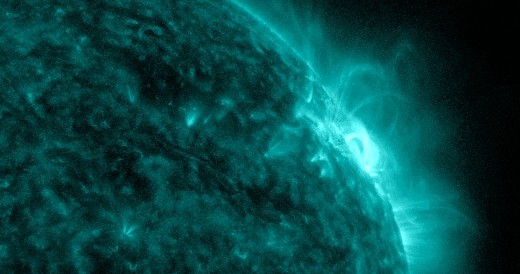
The source of the flare was departing sunspot AR3559. Not all flares cause radiation storms, but this one did because the sunspot is unusually well connected to Earth.
That may seem counterintuitive, because the sunspot is not directly facing our planet. However, when sunspots are near the sun's western limb (as AR3559 is), they can link to Earth magnetically. Take a look at this diagram, and you'll understand why. It's called "the Parker Spiral." Protons accelerated by the flare are now following the Parker Spiral toward Earth and raining down on our atmosphere.
NOAA's GOES-18 satellite is recording the protons as they pass by en route to Earth:
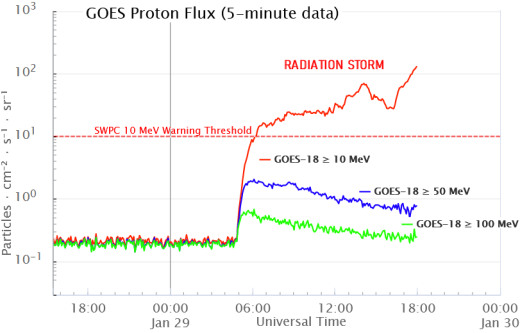
The three colors represent different energy ranges. Blue and green are especially noteworthy; they trace the most energetic protons capable of penetrating the metal hulls of satellites and aircraft. A significant pulse of these "hard" protons was recorded in the hours immediately after the flare.
The explosion also hurled a CME into space, shown here in a coronagraph animation from the Solar and Heliospheric Observatory (SOHO):
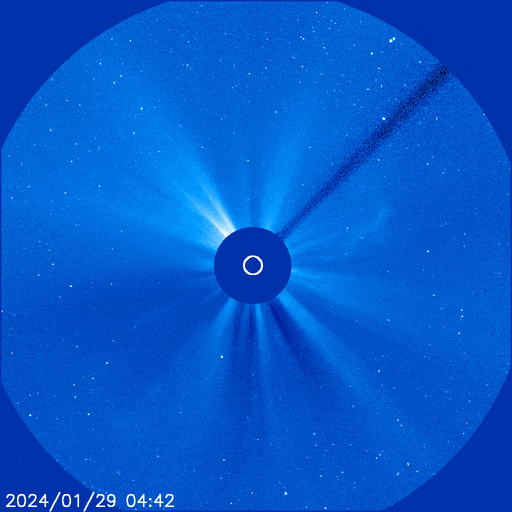
The many speckles in the animation are solar protons striking the spacecraft's camera. It is a sign and side-effect of the radiation storm. A NASA model of the CME suggests it will graze Earth during the early hours of Jan. 31st. Confirmation awaits independent modeling by NOAA.
Realtime Space Weather Photo Gallery
Free: Spaceweather.com Newsletter
SNOOPY & WOODSTOCK FOR VALENTINE'S DAY: Does your Valentine love Snoopy and Woodstock? This is the perfect gift for them. On Jan. 26th, the students of Earth to Sky Calculus launched the pair to the stratosphere onboard a cosmic ray research balloon:
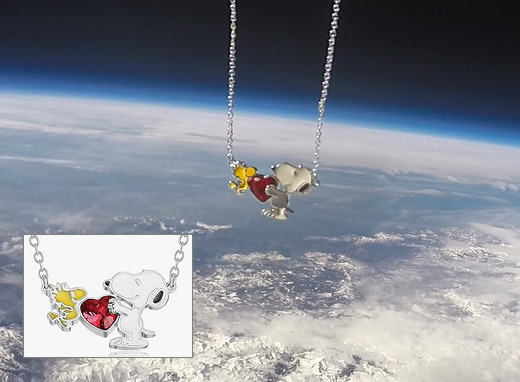
You can have this premium pendant for $149.95. Framed by sterling silver, Snoopy is handing Woodstock a miniature ruby heart, expressing a joyous affection that will delight any Peanuts fan.
The students are selling space pendants to pay the helium bill for their cosmic ray ballooning program. Each one comes with a greeting card showing the jewelry in flight and telling the story of its trip to the stratosphere and back again.
Far Out Gifts: Earth to Sky Store
All sales support hands-on STEM education
Realtime Aurora Photo Gallery
Free: Spaceweather.com Newsletter
Realtime Comet Photo Gallery
Free: Spaceweather.com Newsletter
Every night, a network of
NASA all-sky cameras scans the skies above the United States for meteoritic fireballs. Automated software maintained by NASA's Meteoroid Environment Office calculates their orbits, velocity, penetration depth in Earth's atmosphere and many other characteristics. Daily results are presented here on Spaceweather.com.
On Jan 28, 2024, the network reported 5 fireballs.
(5 sporadics)
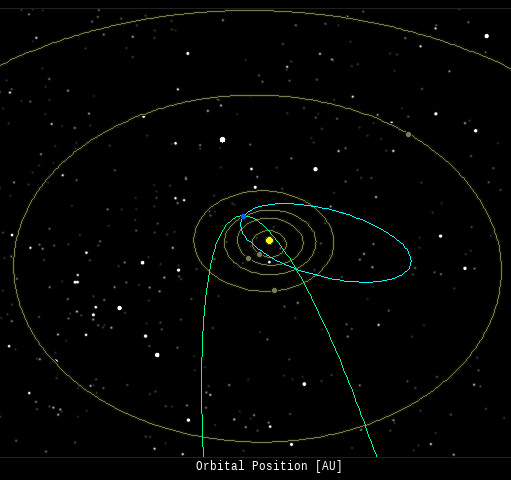
In this diagram of the inner solar system, all of the fireball orbits intersect at a single point--Earth. The orbits are color-coded by velocity, from slow (red) to fast (blue). [Larger image] [movies]
Potentially Hazardous Asteroids (
PHAs) are space rocks larger than approximately 100m that can come closer to Earth than 0.05 AU. None of the known PHAs is on a collision course with our planet, although astronomers are finding
new ones all the time.
On January 29, 2024 there were 2349 potentially hazardous asteroids.
 |
Recent & Upcoming Earth-asteroid encounters: | Asteroid | Date(UT) | Miss Distance | Velocity (km/s) | Diameter (m) |
| 2024 AL6 | 2024-Jan-24 | 5.5 LD | 27 | 26 |
| 2017 BG92 | 2024-Jan-25 | 11.8 LD | 6.3 | 6 |
| 2011 CQ1 | 2024-Jan-26 | 11.3 LD | 4.6 | 1 |
| 2024 BJ | 2024-Jan-27 | 0.9 LD | 6.3 | 20 |
| 2024 BF1 | 2024-Jan-27 | 10.5 LD | 26 | 77 |
| 2024 AU4 | 2024-Jan-28 | 16.5 LD | 17.4 | 83 |
| 2024 AT1 | 2024-Jan-30 | 20 LD | 21.4 | 150 |
| 2024 BA3 | 2024-Jan-30 | 1.6 LD | 5.8 | 6 |
| 2007 EG | 2024-Jan-30 | 16 LD | 8.6 | 43 |
| 2003 BM4 | 2024-Feb-01 | 8.7 LD | 10.9 | 37 |
| 2024 BY | 2024-Feb-01 | 6.6 LD | 5.4 | 20 |
| 2008 OS7 | 2024-Feb-02 | 7.5 LD | 18.2 | 285 |
| 2024 BP1 | 2024-Feb-02 | 8.9 LD | 7.2 | 40 |
| 2019 CC5 | 2024-Feb-04 | 19.2 LD | 15 | 139 |
| 2024 BO | 2024-Feb-06 | 19.9 LD | 6.1 | 32 |
| 2023 SP1 | 2024-Feb-07 | 14.3 LD | 11.8 | 256 |
| 2024 BH | 2024-Feb-10 | 18.4 LD | 8.1 | 78 |
| 2020 DK | 2024-Feb-12 | 8.9 LD | 9.9 | 22 |
| 2024 AO | 2024-Feb-16 | 9.3 LD | 7.3 | 53 |
| 2019 DA1 | 2024-Mar-03 | 14.6 LD | 13.4 | 22 |
| 2015 FM34 | 2024-Mar-12 | 19.4 LD | 11.1 | 113 |
| 2020 FU | 2024-Mar-15 | 14.9 LD | 15.5 | 19 |
| 2020 FD | 2024-Mar-18 | 4.5 LD | 15.1 | 10 |
| 2019 CJ | 2024-Mar-24 | 12.4 LD | 4.4 | 30 |
| 2021 CF6 | 2024-Mar-25 | 14.5 LD | 8.3 | 63 |
Notes: LD means "Lunar Distance." 1 LD = 384,401 km, the distance between Earth and the Moon. 1 LD also equals 0.00256 AU. | | Cosmic Rays in the Atmosphere |
SPACE WEATHER BALLOON DATA: Almost once a week, Spaceweather.com and the students of Earth to Sky Calculus fly space weather balloons to the stratosphere over California. These balloons are equipped with sensors that detect secondary cosmic rays, a form of radiation from space that can penetrate all the way down to Earth's surface. Our monitoring program has been underway without interruption for 7 years, resulting in a unique dataset of in situ atmospheric measurements.
Latest results (July 2022): Atmospheric radiation is decreasing in 2022. Our latest measurements in July 2022 registered a 6-year low:
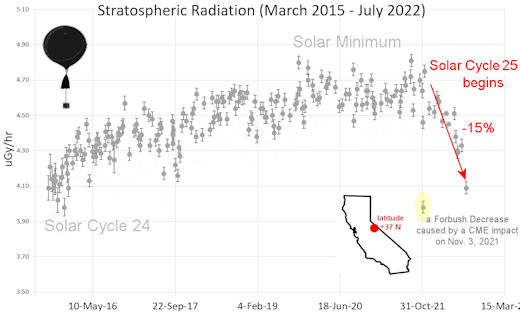
What's going on? Ironically, the radiation drop is caused by increasing solar activity. Solar Cycle 25 has roared to life faster than forecasters expected. The sun's strengthening and increasingly tangled magnetic field repels cosmic rays from deep space. In addition, solar coronal mass ejections (CMEs) sweep aside cosmic rays, causing sharp reductions called "Forbush Decreases." The two effects blend together to bring daily radiation levels down.
.Who cares? Cosmic rays are a surprisingly "down to Earth" form of space weather. They can alter the chemistry of the atmosphere, trigger lightning, and penetrate commercial airplanes. According to a study from the Harvard T.H. Chan school of public health, crews of aircraft have higher rates of cancer than the general population. The researchers listed cosmic rays, irregular sleep habits, and chemical contaminants as leading risk factors. A number of controversial studies (#1, #2, #3, #4) go even further, linking cosmic rays with cardiac arrhythmias and sudden cardiac death.
Technical notes: The radiation sensors onboard our helium balloons detect X-rays and gamma-rays in the energy range 10 keV to 20 MeV. These energies span the range of medical X-ray machines and airport security scanners.
Data points in the graph labeled "Stratospheric Radiation" correspond to the peak of the Regener-Pfotzer maximum, which lies about 67,000 feet above central California. When cosmic rays crash into Earth's atmosphere, they produce a spray of secondary particles that is most intense at the entrance to the stratosphere. Physicists Eric Regener and Georg Pfotzer discovered the maximum using balloons in the 1930s and it is what we are measuring today.
| | The official U.S. government space weather bureau |
| | The first place to look for information about sundogs, pillars, rainbows and related phenomena. |
| | Researchers call it a "Hubble for the sun." SDO is the most advanced solar observatory ever. |
| | 3D views of the sun from NASA's Solar and Terrestrial Relations Observatory |
| | Realtime and archival images of the Sun from SOHO. |
| | information about sunspots based on the latest NOAA/USAF Active Region Summary |
| | current counts of failed and deployed Starlink satellites from Jonathan's Space Page |
| | Authoritative predictions of space junk and satellite re-entries |
| | from the NOAA Space Environment Center |
| | fun to read, but should be taken with a grain of salt! Forecasts looking ahead more than a few days are often wrong. |
| | from the NOAA Space Environment Center |
| | the underlying science of space weather |
 | When looking for casinos to play online when the weather is bad, you can try the SkyCity Online Casino if you are located in New Zealand. If you are not from NZ you can try the Swedish page Svenska casino online to find suitable games, check out svenskacasinoonline.net. Always check your local laws before playing with real money.. |
 | BestCSGOGambling is the best site for everything related to CSGO gambling on the web |
| | These links help Spaceweather.com stay online. Thank you to our supporters! |
| | | | | | |

